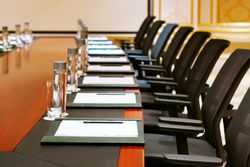3 Factors to Consider When Designing a Conference Room

In addition to employee desks, supervisor offices, and break rooms, a well-designed workplace should have a multi-functional, comfortable conference room. This space will make it easier for staffers to focus during training sessions and general presentations. When deciding on the layout, ergonomic products, and additional elements, take the following into account.
How Should You Design a Conference Room?
1. Size
As operations grow, you might add more personnel to the team. Even if only one or two departments use the conference room at a time, size it as if everyone in the office will be in attendance. This strategy ensures there will be ample space for enough chairs, so no one has to stand for long periods and get fidgety, irritable, and unfocused.
2. Comfort
 Even with enough chairs for everyone, you should choose ergonomic products to ensure your staff remains comfortable while seated. Ergonomic chairs have adjustable seats, backrests, and headrest heights to support the spinal column. Being able to change the backrest angle also takes pressure off the vertebrae. It'll be easier for employees to concentrate during long meetings when they aren’t thinking about their neck, leg, and back pain.
Even with enough chairs for everyone, you should choose ergonomic products to ensure your staff remains comfortable while seated. Ergonomic chairs have adjustable seats, backrests, and headrest heights to support the spinal column. Being able to change the backrest angle also takes pressure off the vertebrae. It'll be easier for employees to concentrate during long meetings when they aren’t thinking about their neck, leg, and back pain.
3. Function
Since most companies conduct business online, place the conference room in an area that receives a strong WiFi connection. Tables should also have docking stations so employees can take notes on laptops and tablets without draining their power. Finally, audio-visual hookups should be placed in walls, ceilings, and counters to operate video conferencing equipment, display monitors, interactive whiteboards, speakers, and microphones.
For conference room furniture and ergonomic products to enhance the comfort and utility of your office, visit Facilitec, Inc. This company is known throughout the St. Louis, MO, metro area for its interior design services and selection of office furniture. For more information on their available products, call (314) 428-4900.
About the Business
Have a question? Ask the experts!
Send your question

